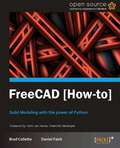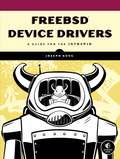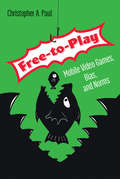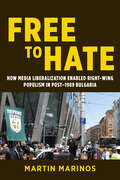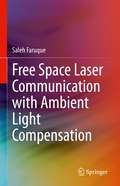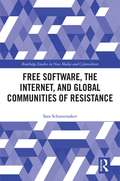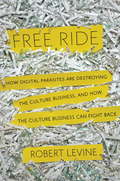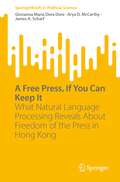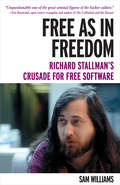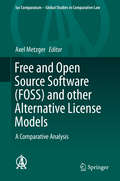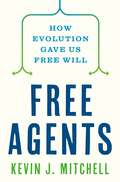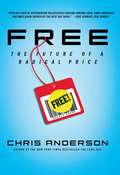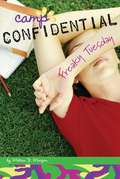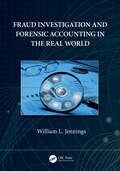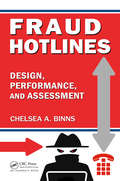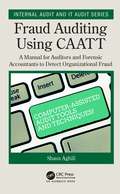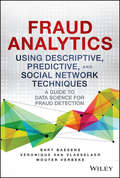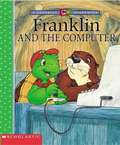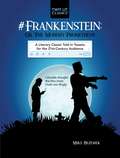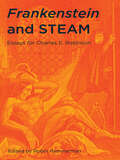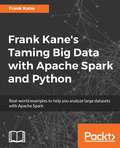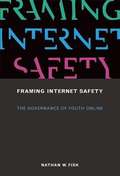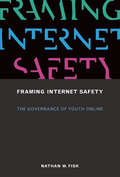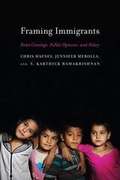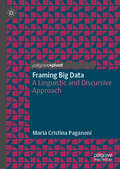- Table View
- List View
FreeCAD: Solid Modeling with the Power of Python
by Brad Collette Daniel FalckWritten in cookbook style, this book offers many recipes to create objects, import and export data, create 3D solid objects. Each recipe contains step-by-step instructions followed by analysis of what was done in each task and other useful information. If you've been toying around with FreeCAD and want to have more control over your work flow then this book is for you. The reader needs to have basic knowledge of modeling.
FreeBSD Device Drivers: A Guide for the Intrepid
by Joseph Kong<P>Device drivers make it possible for your software to communicate with your hardware, and because every operating system has specific requirements, driver writing is nontrivial. When developing for FreeBSD, you've probably had to scour the Internet and dig through the kernel sources to figure out how to write the drivers you need. Thankfully, that stops now. In FreeBSD Device Drivers, Joseph Kong will teach you how to master everything from the basics of building and running loadable kernel modules to more complicated topics like thread synchronization. <P>After a crash course in the different FreeBSD driver frameworks, extensive tutorial sections dissect real-world drivers like the parallel port printer driver. <P>You'll learn: <br>–All about Newbus, the infrastructure used by FreeBSD to manage the hardware devices on your system <br>–How to work with ISA, PCI, USB, and other buses–The best ways to control and communicate with the hardware devices from user space <br>–How to use Direct Memory Access (DMA) for maximum system performance <br>–The inner workings of the virtual null modem terminal driver, the USB printer driver, the Intel PCI Gigabit Ethernet adapter driver, and other important drivers <br>–How to use Common Access Method (CAM) to manage host bus adapters (HBAs)Concise descriptions and extensive annotations walk you through the many code examples. Don't waste time searching man pages or digging through the kernel sources to figure out how to make that arcane bit of hardware work with your system. FreeBSD Device Drivers gives you the framework that you need to write any driver you want, now.
Free-to-Play: Mobile Video Games, Bias, and Norms
by Christopher A. PaulAn examination of free-to-play and mobile games that traces what is valued and what is marginalized in discussions of games.Free-to-play and mobile video games are an important and growing part of the video game industry, and yet they are often disparaged by journalists, designers, and players and pronounced inferior to to games with more traditional payment models. In this book, Christopher Paul shows that underlying the criticism is a bias against these games that stems more from who is making and playing them than how they are monetized. Free-to-play and mobile games appeal to a different kind of player, many of whom are women and many of whom prefer different genres of games than multi-level action-oriented killing fests. It's not a coincidence that some of the few free-to-play games that have been praised by games journalists are League of Legends and World of Tanks.
Free to Hate: How Media Liberalization Enabled Right-Wing Populism in Post-1989 Bulgaria (Geopolitics of Information)
by Martin MarinosLinking neoliberalism with the Right’s global rise Bulgaria’s media-driven pivot to right-wing populism parallels political developments taking place around the world. Martin Marinos applies a critical political economy approach to place Bulgarian right-wing populism within the structural transformation of the country’s media institutions. As Marinos shows, media concentration under Western giants like Westdeutsche Allgemeine Zeitung and News Corporation have led to a neoliberal turn of commercialization, concentration, and tabloidization across media. The Right have used the anticommunism and racism bred by this environment to not only undermine traditional media but position their own outlets to boost new political entities like the nationalist party Ataka. Marinos’s ethnographic observations and interviews with local journalists, politicians, and media experts add on-the-ground detail to his account. He also examines several related issues, including the performative appeal of populist media and the money behind it. A timely and innovative analysis, Free to Hate reveals where structural changes in media intersect with right-wing populism.
Free Space Laser Communication with Ambient Light Compensation
by Saleh FaruqueThis book addresses 5G network capacity requirements with a new architecture for 5G Optical Backhaul Network. The author first describes the challenges for 5G backhaul network requirements and then the details of an Optical Backhaul Network for 5G. The author describes an architecture, in which small cells deploy as a cluster (i.e., 3-5 small cells in one cluster), where one small cell works as an aggregation point using an optical transceiver to backhaul the aggregated traffic to the nearest optical network unit, before it then goes to the core network. This book also illustrates the optical link budget analysis that can be used to determine the availability and the performances of the optical backhaul link in different deployment scenarios and different weather conditions. Provides a single-source reference to the basics of free space laser communication with ambient light compensation;Offers timely information, blending theory and practice;Written to be accessible to readers with varying backgrounds, including numerous illustrations;Provides hands-on experience through practical examples, which can be put to work to deploy and optimize cellular networks.
Free Software, the Internet, and Global Communities of Resistance: Hacking the Global (Routledge Studies in New Media and Cyberculture)
by Sara SchoonmakerThis book explores software's pivotal role as the code that powers computers, mobile devices, the Internet, and social media. Creating conditions for the ongoing development and use of software, including the Internet as a communications infrastructure, is one of the most compelling issues of our time. Free software is based upon open source code, developed in peer communities as well as corporate settings, challenging the dominance of proprietary software firms and promoting the digital commons. Drawing upon key cases and interviews with free software proponents based in Europe, Brazil and the U.S., the book explores pathways toward creating the digital commons and examines contemporary political struggles over free software, privacy and civil liberties on the Internet that are vital for the commons' continued development.
Free Ride
by Robert LevineHow did the newspaper, music, and film industries go from raking in big bucks to scooping up digital dimes? Their customers were lured away by the free ride of technology. Now, business journalist Robert Levine shows how they can get back on track. On the Internet, "information wants to be free." This memorable phrase shaped the online business model, but it is now driving the media companies on whom the digital industry feeds out of business. Today, newspaper stocks have fallen to all-time lows as papers are pressured to give away content, music sales have fallen by more than half since file sharing became common, TV ratings are plummeting as viewership migrates online, and publishers face off against Amazon over the price of digital books. In Free Ride, Robert Levine narrates an epic tale of value destruction that moves from the corridors of Congress, where the law was passed that legalized YouTube, to the dorm room of Shawn Fanning, the founder of Napster; from the bargain-pricing dramas involving iTunes and Kindle to Google's fateful decision to digitize first and ask questions later. Levine charts how the media industry lost control of its destiny and suggests innovative ways it can resist the pull of zero. Fearless in its reporting and analysis, Free Ride is the business history of the decade and a much-needed call to action.From the Hardcover edition.
A Free Press, If You Can Keep It: What Natural Language Processing Reveals About Freedom of the Press in Hong Kong (SpringerBriefs in Political Science)
by Giovanna Maria Dore Arya D. McCarthy James A. ScharfThis Brief introduces a novel research approach to investigate freedom of the press in Hong Kong. The authors pair computational analyses from the field of natural language processing with qualitative content analysis of patterns of journalistic practice in volatile political settings. Together, these shed light on the evolution of press freedom in Hong Kong since its return to Chinese sovereignty. Providing an interdisciplinary perspective, the Brief will appeal to a wide range of readers with interests in computational social science, public policy, political sciences as well as policy-makers, think tanks, and practitioners who focus on the China-Hong Kong nexus.
Free as in Freedom: Richard Stallman's Crusade for Free Software
by Sam Williams<p><i>Free as in Freedom</i> interweaves biographical snapshots of GNU project founder Richard Stallman with the political, social and economic history of the free software movement. It examines Stallman's unique personality and how that personality has been at turns a driving force and a drawback in terms of the movement's overall success. </p>
Free and Open Source Software (FOSS) and other Alternative License Models
by Axel MetzgerThis book discusses the main legal questions raised by free and open source software (FOSS) licenses and other alternative license models, such as Creative Commons. The legal questions raised by FOSS and other alternative licenses have been the subject of an intense international debate among legal scholars and practising lawyers in the last years. Courts in different jurisdictions have confirmed that the core features of FOSS licenses are compliant with the respective applicable laws and thus enforceable in the respective jurisdictions. What is still missing so far is an in-depth comparative analysis of the legal issues raised by FOSS, Creative Commons and other alternative license on a worldwide scale. This book presents a general report on FOSS licenses and alternative license models to establish common ground and enable comparison between jurisdictions. The general report is followed by 24 national reports covering the world's most important IT-markets. General and national reports use the same structure to facilitate the comparison. The book shows that despite the differences in their origins, all FOSS projects use detailed licenses for the organisation of their communities. It also shows the differences in the proofing of these licenses by courts in some jurisdictions and the tailor-made provisions established by some legislators to solve the legal issues raised by the license model.
Free Agents: How Evolution Gave Us Free Will
by Kevin J. MitchellAn evolutionary case for the existence of free willScientists are learning more and more about how brain activity controls behavior and how neural circuits weigh alternatives and initiate actions. As we probe ever deeper into the mechanics of decision making, many conclude that agency—or free will—is an illusion. In Free Agents, leading neuroscientist Kevin Mitchell presents a wealth of evidence to the contrary, arguing that we are not mere machines responding to physical forces but agents acting with purpose.Traversing billions of years of evolution, Mitchell tells the remarkable story of how living beings capable of choice arose from lifeless matter. He explains how the emergence of nervous systems provided a means to learn about the world, granting sentient animals the capacity to model, predict, and simulate. Mitchell reveals how these faculties reached their peak in humans with our abilities to imagine and to be introspective, to reason in the moment, and to shape our possible futures through the exercise of our individual agency. Mitchell’s argument has important implications—for how we understand decision making, for how our individual agency can be enhanced or infringed, for how we think about collective agency in the face of global crises, and for how we consider the limitations and future of artificial intelligence.An astonishing journey of discovery, Free Agents offers a new framework for understanding how, across a billion years of Earth history, life evolved the power to choose, and why it matters.
Free: The Future of a Radical Price
by Chris AndersonThe online economy offers challenges to traditional businesses as well as incredible opportunities. Chris Anderson makes the compelling case that in many instances businesses can succeed best by giving away more than they charge for. Known as "Freemium," this combination of free and paid is emerging as one of the most powerful digital business models. In Free, Chris Anderson explores this radical idea for the new global economy and demonstrates how it can be harnessed for the benefit of consumers and businesses alike. In the twenty-first century, Free is more than just a promotional gimmick: It's a business strategy that is essential to a company's successful future.
Freaky Tuesday (Camp Confidential #17)
by Melissa J. MorganBrynn's just transferred to a brand-new school in a town close by. A town in Bizarro World, that is, where academic excellence is the fast track to popularity and Candace yes, quiet, seemingly insecure Candace is the reigning queen bee.
Fraud Investigation and Forensic Accounting in the Real World
by William L. JenningsThis book covers every aspect of forensic accounting, anti-fraud control systems, and fraud investigations. The author uses his own case experience to guide the reader through each phase of a forensic accounting assignment and fraud investigation. The book opens with an explanation of what happened to a company that was ensnared in a huge commodity purchasing scheme. Using his knowledge and experience gained over 40 years, the author illustrates that unexpected fraud occurrences can happen to any company, in any industry. Additionally, the author explains the current white-collar crime threats that organizations face every day, as well as legal issues that are often implicated in forensic accounting and fraud investigation projects. Electronic and non-electronic evidence gathering is also covered in detail with illustrative examples. One chapter is devoted entirely to the often misunderstood, but extremely important, subject of witness interviews. It provides the correct approach to the analysis and correlation of evidence in determining findings and conclusions of an investigation. Another chapter is devoted to proper report writing. The author provides detailed guidance on presenting findings to a variety of audiences, including management, a board, law enforcement, and at trials and hearings. It also covers proper techniques for measuring economic damages and concludes with a useful index. William L. Jennings is a Senior Director at Delta Consulting Group. He is responsible for providing forensic accounting, investigation, and asset recovery services to corporations, government agencies, attorneys, and their clients, as well as business controls consulting services to organizations. With more than 40 years of experience in public accounting and auditing, forensic accounting, business valuation, investigation, asset recovery, and business controls development, Mr. Jennings has worked on hundreds of forensic accounting and investigation assignments and he provides expert testimony.
Fraud Hotlines: Design, Performance, and Assessment
by Chelsea A. BinnsThis book provides a complete guide on fraud hotlines. It is designed to educate readers with respect to the history, purpose, operation, use and utility of fraud hotlines. It also equips readers with the knowledge to create, analyze and assess the performance of fraud hotlines.
Fraud Auditing Using CAATT: A Manual for Auditors and Forensic Accountants to Detect Organizational Fraud (Internal Audit and IT Audit)
by Shaun AghiliThis book discusses various common occupational and organizational fraud schemes, based on the Association of Certified Fraud Examiners (ACFE) fraud tree and assist fraud examiners and auditors in correctly choosing the appropriate audit tests to uncover such various fraud schemes. The book also includes information about audit test red flags to watch out for, a list of recommended controls to help prevent future fraud related incidents, as well as step-by-step demonstrations of a number of common audit tests using IDEA® as a CAATT tool.
Fraud Analytics Using Descriptive, Predictive, and Social Network Techniques
by Veronique Van Vlasselaer Wouter Verbeke Bart BaesensDetect fraud earlier to mitigate loss and prevent cascading damage Fraud Analytics Using Descriptive, Predictive, and Social Network Techniques is an authoritative guidebook for setting up a comprehensive fraud detection analytics solution. Early detection is a key factor in mitigating fraud damage, but it involves more specialized techniques than detecting fraud at the more advanced stages. This invaluable guide details both the theory and technical aspects of these techniques, and provides expert insight into streamlining implementation. Coverage includes data gathering, preprocessing, model building, and post-implementation, with comprehensive guidance on various learning techniques and the data types utilized by each. These techniques are effective for fraud detection across industry boundaries, including applications in insurance fraud, credit card fraud, anti-money laundering, healthcare fraud, telecommunications fraud, click fraud, tax evasion, and more, giving you a highly practical framework for fraud prevention. It is estimated that a typical organization loses about 5% of its revenue to fraud every year. More effective fraud detection is possible, and this book describes the various analytical techniques your organization must implement to put a stop to the revenue leak. Examine fraud patterns in historical data Utilize labeled, unlabeled, and networked data Detect fraud before the damage cascades Reduce losses, increase recovery, and tighten security The longer fraud is allowed to go on, the more harm it causes. It expands exponentially, sending ripples of damage throughout the organization, and becomes more and more complex to track, stop, and reverse. Fraud prevention relies on early and effective fraud detection, enabled by the techniques discussed here. Fraud Analytics Using Descriptive, Predictive, and Social Network Techniques helps you stop fraud in its tracks, and eliminate the opportunities for future occurrence.
Franklin and the Computer
by Paulette BourgeoisFranklin is totally into Beaver's new computer game, Dam Builders. He keeps popping up at her house and spends all his time playing Dam Builders. He's so obsessed with reaching the next level in the game that he turns down Beaver's invitation to go swimming and even forgets his promise to Bear to show up for soccer practice--twice. One day Franklin finds himself alone; all his friends are at the pond. They are glad when Franklin joins them for a real game of dam builders, and Franklin realizes that friends are the most fun of all. Picture descriptions added.
#Frankenstein; Or, The Modern Prometheus: A Literary Classic Told in Tweets for the 21st Century Audience (Twit Lit Classics)
by Mike BezemekFew classic works of literature have excited such enduring popular interest among the general public as Frankenstein. But suppose the characters?Victor Frankenstein, Captain Robert Walton, and, yes, even the ?monster??had shared their tale in tweets? #Frankenstein; Or, The Modern Prometheus in Tweets hilariously reimagines Mary Shelley?s classic gothic novel in about 200 tweets, each 140 characters or less. @FrankenDrVictor: A rainy Nov night under dying candle I infused the spark. A gasp! A convulsion of limbs! A yellow eye opened. ;P WTF have I done? In this witty abridgment, Victor Frankenstein?s quest to create a sentient being is retold with the occasional emoji. The plight of his monstrous creation is presented with internet acronyms. And Captain Robert Walton ponders the blinding power of ambition with hashtags. Including an appendix that presents the original passages upon which each tweet is derived, #Frankenstein offers modern readers an entertaining and accessible companion to a great American classic.
Frankenstein and STEAM: Essays for Charles E. Robinson
by Susan J. Wolfson Mark A. McCutcheon Lisa Crafton Siobhan Watters Lisbeth Chapin L. Adam Mekler Brian Bates Robin HammermanCharles E. Robinson, Professor Emeritus of English at The University of Delaware, definitively transformed study of the novel Frankenstein with his foundational volume The Frankenstein Notebooks and, in nineteenth century studies more broadly, brought heightened attention to the nuances of writing and editing. Frankenstein and STEAM consolidates the generative legacy of his later work on the novel's broad relation to topics in science, technology, engineering, arts, and mathematics (STEAM). Seven chapters written by leading and emerging scholars pay homage to Robinson's later perspectives of the novel and a concluding postscript contains remembrances by his colleagues and students. This volume not only makes explicit the question of what it means to be human, a question Robinson invited students and colleagues to examine throughout his career, but it also illustrates the depth of the field and diversity of those who have been inspired by Robinson's work. Frankenstein and STEAM offers direction for continuing scholarship on the intersections of literature, science, and technology. Published by the University of Delaware Press. Distributed worldwide by Rutgers University Press.
Frank Kane's Taming Big Data with Apache Spark and Python
by Frank KaneFrank Kane's hands-on Spark training course, based on his bestselling Taming Big Data with Apache Spark and Python video, now available in a book. Understand and analyze large data sets using Spark on a single system or on a cluster. About This Book • Understand how Spark can be distributed across computing clusters • Develop and run Spark jobs efficiently using Python • A hands-on tutorial by Frank Kane with over 15 real-world examples teaching you Big Data processing with Spark Who This Book Is For If you are a data scientist or data analyst who wants to learn Big Data processing using Apache Spark and Python, this book is for you. If you have some programming experience in Python, and want to learn how to process large amounts of data using Apache Spark, Frank Kane's Taming Big Data with Apache Spark and Python will also help you. What You Will Learn • Find out how you can identify Big Data problems as Spark problems • Install and run Apache Spark on your computer or on a cluster • Analyze large data sets across many CPUs using Spark's Resilient Distributed Datasets • Implement machine learning on Spark using the MLlib library • Process continuous streams of data in real time using the Spark streaming module • Perform complex network analysis using Spark's GraphX library • Use Amazon's Elastic MapReduce service to run your Spark jobs on a cluster In Detail Frank Kane's Taming Big Data with Apache Spark and Python is your companion to learning Apache Spark in a hands-on manner. Frank will start you off by teaching you how to set up Spark on a single system or on a cluster, and you'll soon move on to analyzing large data sets using Spark RDD, and developing and running effective Spark jobs quickly using Python. Apache Spark has emerged as the next big thing in the Big Data domain – quickly rising from an ascending technology to an established superstar in just a matter of years. Spark allows you to quickly extract actionable insights from large amounts of data, on a real-time basis, making it an essential tool in many modern businesses. Frank has packed this book with over 15 interactive, fun-filled examples relevant to the real world, and he will empower you to understand the Spark ecosystem and implement production-grade real-time Spark projects with ease. Style and approach Frank Kane's Taming Big Data with Apache Spark and Python is a hands-on tutorial with over 15 real-world examples carefully explained by Frank in a step-by-step manner. The examples vary in complexity, and you can move through them at your own pace.
Framing Internet Safety: The Governance of Youth Online
by Nathan W. FiskSince the beginning of the Internet era, it has become almost impossible to discuss youth and technology without mentioning online danger -- pornography that is just a click away, lurking sexual predators, and inescapable cyberbullies. In this book, Nathan Fisk takes an innovative approach to the subject, examining youth Internet safety as a technology of governance -- for information technologies and, by extension, for the forms of sociality and society they make possible. He argues that it is through the mobilization of various discourses of online risk that the everyday lives of youth are increasingly monitored and policed and the governing potentials of information technologies are explored. Fisk relates particular panics over youth Internet safety to patterns of technological adoption by young people, focusing on the policy response at the federal level aimed at producing future cybercitizens. He describes pedagogies of surveillance, which position parents as agents of surveillance; the evolution of the youth Internet safety curricula, as seen through materials on cyberbullying and online reputation management; and, drawing on survey results and focus groups, parent and child everyday practice. Finally, Fisk offers recommendations for a "cybersafety of everyday life," connecting youth Internet safety to trends in national infrastructure protection and corporate information assurance.
Framing Internet Safety: The Governance of Youth Online (The John D. and Catherine T. MacArthur Foundation Series on Digital Media and Learning)
by Nathan W. FiskAn examination of youth Internet safety as a technology of governance, seen in panics over online pornography, predators, bullying, and reputation management.Since the beginning of the Internet era, it has become almost impossible to discuss youth and technology without mentioning online danger—pornography that is just a click away, lurking sexual predators, and inescapable cyberbullies. In this book, Nathan Fisk takes an innovative approach to the subject, examining youth Internet safety as a technology of governance—for information technologies and, by extension, for the forms of sociality and society they make possible. He argues that it is through the mobilization of various discourses of online risk that the everyday lives of youth are increasingly monitored and policed and the governing potentials of information technologies are explored. Fisk relates particular panics over youth Internet safety to patterns of technological adoption by young people, focusing on the policy response at the federal level aimed at producing future cybercitizens. He describes pedagogies of surveillance, which position parents as agents of surveillance; the evolution of the youth Internet safety curricula, as seen through materials on cyberbullying and online reputation management; and, drawing on survey results and focus groups, parent and child everyday practice. Finally, Fisk offers recommendations for a “cybersafety of everyday life,” connecting youth Internet safety to trends in national infrastructure protection and corporate information assurance.
Framing Immigrants: News Coverage, Public Opinion, and Policy
by Chris Haynes Jennifer Merolla S. Karthick RamakrishnanWhile undocumented immigration is controversial, the general public is largely unfamiliar with the particulars of immigration policy. Given that public opinion on the topic is malleable, to what extent do mass media shape the public debate on immigration? In Framing Immigrants, political scientists Chris Haynes, Jennifer Merolla, and Karthick Ramakrishnan explore how conservative, liberal, and mainstream news outlets frame and discuss undocumented immigrants. Drawing from original voter surveys, they show that how the media frames immigration has significant consequences for public opinion and has implications for the passage of new immigration policies. The authors analyze media coverage of several key immigration policy issues—including mass deportations, comprehensive immigration reform, and measures focused on immigrant children, such as the DREAM Act—to chart how news sources across the ideological spectrum produce specific “frames” for the immigration debate. In the past few years, liberal and mainstream outlets have tended to frame immigrants lacking legal status as “undocumented” (rather than “illegal”) and to approach the topic of legalization through human-interest stories, often mentioning children. Conservative outlets, on the other hand, tend to discuss legalization using impersonal statistics and invoking the rule of law. Yet, regardless of the media’s ideological positions, the authors’ surveys show that “negative” frames more strongly influence public support for different immigration policies than do positive frames. For instance, survey participants who were exposed to language portraying immigrants as law-breakers seeking “amnesty” tended to oppose legalization measures. At the same time, support for legalization was higher when participants were exposed to language referring to immigrants living in the United States for a decade or more. Framing Immigrants shows that despite heated debates on immigration across the political aisle, the general public has yet to form a consistent position on undocumented immigrants. By analyzing how the media influences public opinion, this book provides a valuable resource for immigration advocates, policymakers, and researchers.
Framing Big Data: A Linguistic and Discursive Approach
by Maria Cristina PaganoniThis book addresses big data as a socio-technical construct with huge potential for innovation in key sectors such as healthcare, government and business. Big data and its increasingly widespread use in such influential spheres can generate ethically controversial decisions, including questions surrounding privacy, consent and accountability. This book attempts to unpack the epistemological implications of the term ‘big data’, as well as the opportunities and responsibilities which come with it. The author analyses the linguistic texture of the big data narrative in the news media, in healthcare and in EU law on data protection, in order to contribute to its understanding from the critical perspective of language studies. The result is a study which will be of interest to students and scholars working in the digital humanities, corpus linguistics, and discourse studies.
